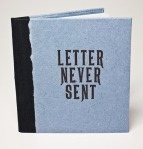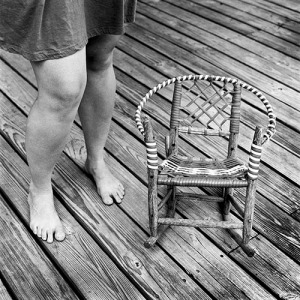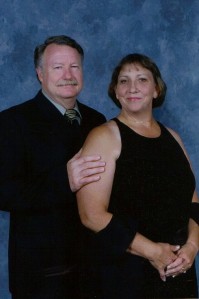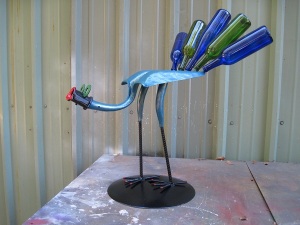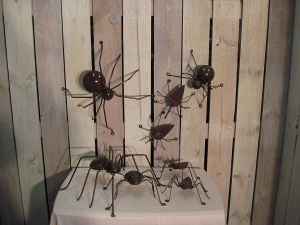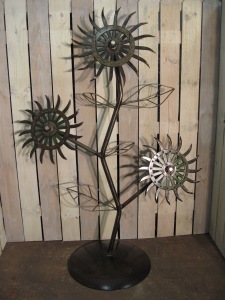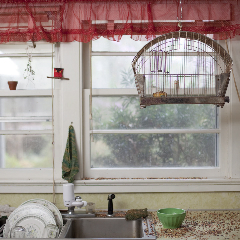This week: Paul and Mary Fran Crook of B & B Theatre. Don't forget to come see RFK this Friday and Saturday at 8pm at the Norton Building.
Interview and transcript edited for length.
[wpvideo qVE76yjr]
This is Q&Art. I'm Russell Pirkle, and today I am interviewing Paul Crook and Mary Fran Crook, professors of theatre at Louisiana Tech and Grambling University respectively, and founders of the B & B Theatre, for which Paul serves as director and Mary Fran as producer.
Could y'all tell me about the show that's coming up . . . next week, is that right?
PC - Next Week. Would you like to do that or should I?
MFC - I will. It's next week, August 19th and 20th at the Norton Building located downtown on Mississippi. Doors open at seven o'clock. The show will begin at eight o'clock. We're trying to avoid as much heat as possible, and are praying for rain to break it out. But again, it is B & B, which stands for Basket and Beverage, so people are welcome to bring a basket of food and their beverage of choice and sit back and enjoy an evening of theatre.
PC - And, decorate their tables!
MFC - Right, decorate their tables, because for this show, which I kind of got inspired by some of the participants who came for Graceland to have a table decorating contest. And the theme is actually patriotism, so bring out your Fourth of July gear and celebrate again. And there will be a prize which is yet to be announced.
PC - That's right. There will be a fabulous prize. We will have a special local celebrity guest judge who will judge the table decorations. And each night he will choose . . .
MFC - Or she!
PC - He or she will choose one table as the winning table, and that table will receive a fabulous prize, fabulous parting gifts.
And the show, that's RFK, is that right?
PC - Yes, that is the name of the show, RFK, written by a man named Jack Holmes.
How did you choose this show?
PC - Mary Fran chose it.
MFC - I actually was given the script by a colleague that I work with at Grambling State University, just to read it. And it was one that once I started it . . . I felt bad because it stayed on my desk for a while, and I had some time so I decided to read it. And I started it, and I couldn't put it down. I was like 'this is such a great play, the history in it.' And I wanted to share it with Paul. And so he read it and felt the same way, and we got together this idea about the B & B Theatre, and we wanted to make it a small cast for the inaugural season. And I thought what about RFK, and you [Paul] play RFK? Because it's always nice, especially for our students to see us actually doing something outside the classroom, showing that we do have some kind of professional work outside. So RFK, I fell in love with it after I first read it, and I'm enjoying the opportunity to get to direct it, especially with my husband. Because this doesn't happen often. Haha.
Ok, so whenever I did the intro, I said that you, Paul, were usually the director . . .
PC - I'm the artistic director of the company. It is weird. I'm the artistic director, and Mary Fran is the producer of the company. But for this show, she's directing the play, and I'm just an actor.
What do you think it was about Robert Kennedy that made him such a unique political figure?
PC - I think a couple of things. One, certainly is his relationship to JFK. The world had a fascination with John F. Kennedy and with Jackie. They were young. They were vibrant. They were passionate. They had big ideas. And Robert was a part of that. And when JFK was assassinated, I think it was natural to look to Robert to carry the torch. But I also don't think that RFK was strictly a coattail rider. He had his own reputation. We see these events in the play. We see his work in the attorney general's office, fighting organized crime, fighting the corruption in the Teamsters' union, his court battles with Sam G. Encana. His court battles with Jimmy Hoffa. We see him come into his own as a political figure, solitary, but he still had a lot of the same qualities that JFK had. He was young. He was vibrant. He was full of new ideas. And that spoke to a generation of people who were looking for change, who were looking for something different than what they had. And it's why anytime a politician comes on the scene who is young, who is advocating change, who is advocating a new direction, they get compared to RFK and JFK. We saw it in 2008 with President Obama's campaign. All of the comparisons between him and JFK and RFK, because here he was, a young guy, 47 I guess when he was elected, he was running on a platform of hope and change. And that tied directly back to RFK, and that resonates with the younger members of a society.
Are there any other actors and actresses in the play besides yourself?
PC - Haha. Unfortunately No. (All laugh) It's just me. It's a one man show. Jack Holmes wrote it actually for himself. He wrote it and did it himself. The first six or so professional performances from workshop performances to off broadway performances to performances in Cincinnati and Boston and other big cities, it was just him. He had a passion for the Kennedy family, and that was what sparked his interest in writing the play. So he wrote it as a one man show, and that's it. RFK is the only character in the play, so it's just me. Talking.
Do you want to speak a little about how this role compares to other roles you've played in the past?
PC - It's a lot more words! Haha. That's a cheesy thing to say, but it's true. Here's the difference: I've done of course big huge shows, and I've had leading role in big shows. I've had small roles in big shows. I've also done a three person show a couple of times. And I've done a two person show a couple of times. And each of those, the fewer actors you get, the more pressure comes on you to bring it as an actor, to be on your game. Because you've got a shared stage. And when you're doing a two person show, and it's just me and you back and forth, man, we both gotta be there. We both gotta go. Take one of those people away, and the pressure just multiplies exponentially. And that's the difficult thing. There's nobody else you can feed off of. There's nobody else up there to share energy with, to share an approach with, to share a communion with. So what happens is the audience takes the place of that other actor. There becomes this give and take between the performer and the audience. And as an actor, I'll be interested to see, having never done a one man show before, how deeply that synergy can work.
MFC - But also, you're playing a historical figure, where your other characters, you kind of built it on your own. But this one, Paul has sat there and researched and listened to clips of RFK, trying to figure out the voice, even to how he says specific words. Because it's been 43 years. That's not a long time ago for a lot of the people who will most likely be coming to see this performance. RFK is still fresh in their memory. JFK, RFK, that whole family is still fresh in their memory. So Paul has really gone a step further trying to recreate Robert Kennedy, not just Paul Crook but Paul Crook portraying Robert Kennedy to the best that he can.
PC - Yeah, and that's a tough part. That's a tough thing, I think. And this is the first time I've played a role who was an actual person so recently in our midst. I've played historical figures in a Shakespearean show. You know, I've played the Duke of York, who was, yes, a real person. But there's nobody alive who remembers the Duke of York. And that's a challenge in this because we're going to have people in the audience that voted for Kennedy. We're going to have people who voted for JFK, or voted against him. Or remember wathing him. Or watched some of the hearings on TV, or saw clips of the hearings. They have a person relationship and a personal memory of him. And I've got to live up to that, which is tough. That's a tough challenge for an actor. And because I'm 42, I was born the year after RFK was assassinated, so all of the research I've done has been relying on youtube clips and stuff I find online to get a feel for . . . How does he sit? How does he walk? How does he talk? Which side did he part his hair on? He had more hair than me, but I'll do the best I can to part it that way. So it's a tough thing.
Mary Fran, could you tell me a little bit about your role as the director?
MFC - Paul made this comment when he was directing Graceland, that with his two actresses, Allie [Allison Gilbert Bennet] and Rebecca [Rebecca E. Taylor], they're just such great performers, that his role comes easy. And it's the same way with directing Paul. It's kind of easy, in a way. I'm just here to be that eye for him. And there are things that maybe he doesn't see that I feel like should be in there, so I've been trying to get him to go that direction. The problem with scripts is that there's always directions in it, and stuff that's expected, but that was also for the first time that it was ever done. But just trying to make sure that I'm getting across what I want the audience to see. And having an audience, it would be nice, because it's just he and I in here and these four walls at times. So just making him get off book, that might help a little bit more, but like he said, it's seventy pages of words. Seventy pages.
PC - Fifty. For the love of God, don't give me seventy!
MFC - Fifty pages of all words.
PC - I couldn't do seventy. Haha.
Could y'all tell me about any other people who have a role in making the B & B Theatre possible?
PC - Yes! One is the North Central Louisiana Arts Council, which has been fabulous. When we had the idea to do this, one thing that we knew is that we couldn't do it ourselves. We had an idea, so we went and we put together a proposal, a presentation, and we went to the Arts Council and proposed it and asked if the Arts Council would be interested in sponsoring this kind of new artistic venture getting of the ground. And one of the things we stressed was, we want this to be a complement to other artistic activites in North Central Louisiana. We don't want to compete. We made very certain when we were choosing the shows and the dates that we weren't going to conflict with anything that RCT was doing, and we weren't going to conflict with anything and the Dixie, and we weren't going to conflict with any art gallery openings that were going on. We want this to be a part of, an addition to the art scene. And so the Arts Council was great. And the Stone family, who helped sponsor it. Kathy Stone, who was at that board meeting, loved the idea and said 'Absolutely. We'll help out in any way that we can.' So the Stone family and the Arts Council. We wouldn't be doing it, if they didn't support us, Mary Fran and I would be sitting at home watching Let's Make a Deal right now. And not rehearsing.
MFC - And the Nortons. They were gracious to let us use the space, provide us with the space at the Norton Building. I've worked with Dean [Norton] before, when I was at the Dixie Center for the Arts, for an event that we had that went with the two. It's just a great space, so definitely the Nortons as well.
PC - Mhm.
MFC - And the community.
PC - Well yeah. And that's the thing. Leigh Anne [Chambers], she helped us out above and beyond her role as the director of the Arts Council. She helped out with Graceland and has been helping out with this. And April. And you. Everybody, the Arts Council has helped getting press releases out, setting up interviews. The Louisiana Tech Department of Theatre has allowed us to use this rehearsal space and some props and some set pieces, which has been really nice. And then, like every theatrical endeavor, it's a communal event, so there are tons and tons of people who help out with it.
You mentioned about wanting to be complementary to the other theatrical and art things that are going on currently. I'm curious, what do you feel about what sort of niche that the B & B Theatre fills that wasn't already?
PC - We look at this as adult theatre is what we say. And everytime I say that I think 'oh my God, it sounds like we're doing porn.' It's not. Haha. It's not that, but it's theatre for adults. Louisiana Tech's theatre department, every theatre caters to a specific audience. Tech's theatre department caters to the campus community, and our season ticket holders, who are typically kind of older members of our community. Ruston Community Theatre targets family audiences. And that's what every good community theatre does. You look at their shows, they're doing shows the whole family can come and enjoy a great evening or afternoon of theatre. They did Annie. A couple of years ago they did Cheaper by the Dozen. And all the shows they have are all fantastic, but they're for families. Likewise, Grambling's target audience is the Grambling campus. What we wanted to provide with the B & B, and the niche we wanted to fill, is theatre for adults to come and enjoy. We don't want you to bring your kids. This should be a date night for the adults, to come out and enjoy. Like Mary Fran said, bring your picnic basket and your dinner, whatever it's going to be. Bring your bottle of wine. Bring your six pack of beer. Bring your whatever. Your two litre of Coca-Cola, whatever it's going to be. But sit back and enjoy shows that are meant to be enjoyed by an adult audience. Whether they're comedy, or whether they're dramas, or what have you. Graceland dealt with mature themes. It dealt with loss. Even though it's a comedy, it dealt with psychological abuse. It dealt with relationships. It dealt with finding yourself. Even though it's a comedy, it was for adults. Same thing holds true with RFK, and this is a theme, we're talking about a past political figure in the United States, not a lot of ten year olds are going to be that interested, I don't think. Haha. But this is for adults. This is intelligently written. It's intelligently directed. I hope it's intelligently performed. And we want an intelligent, mature audience to come and sit back and enjoy an evening of entertainment.
I know you both have a wealth of theatrical experience, but were there any new challenges or experiences involved in creating and running the B & B Theatre?
MFC - With this play specifically, because it is two acts, four scenes in the first act and five scenes in the second act, and there's all these transitions that lighting would really come in handy. So in having a dance background, I'm one that I choreograph everything, I really do. That's how I like to direct. And trying to get all of this to run together, and our hope right now is that we do this without and intermission. We've just got to see if we can. I've got water breaks, you know 'take a sip of water here, take a sip of water there.' But the lighting aspect has been . . . But other than that, theatre can be done anywhere. It's like Peter Brooks said, 'you just need a person walking across the floor and one person watching, that's theatre.' It can go anywhere.
PC - And I think, the only challenge in terms of the theatre company itself is people need to get used to us. It's something new that's in town. When we set out to do this, we said 'alright, we want to bring professional theatre to Ruston. We want to use this first year to see it's successful, if there's an audience for it. 'Cause you never know. There may not be. But We think there will be.' And if this is successful, and if RFK is as successful or more successful than Graceland was, then we'll look to do it again next year. But the other thing, and this goes back to your earlier question about what niche we fill, our goal is we do want this to be, for all intents and purposes, a professional theatre company. The people that we're going to hire to work are people who have worked professionally before. This is not something we take lightly. We're both very serious about it. If we're going to choose a show, and we're going to choose actors for the show, we want to make sure that everybody has worked professionally before, has got that experience. They've got a certain level of training and experience that allows them to work in these conditions. Because one of the biggest differences between what we're doing with the B & B and say what we do at Tech, at Tech we typically will rehearse shows for five or six weeks. Sometimes even seven. And you're looking at rehearsals six days a week, three hours a day. Well, being in the summer, because we're working small, and because we're working with all professionals here, we're rehearsing these in two weeks. And we're rehearsing, depending on however long in the afternoon or evening or morning, whenever we're scheduling our rehearsals, we're putting it together quickly. And there's a pacing to it that you have to have done before and be used to in order for it to work. And if I just pulled a couple of my students, or a couple of Mary Fran's students out, if they had not done this before, they woudn't be able to do it now. There's nothing wrong with that. They just haven't had that experience. So that's why we're looking to make this as smooth as possible so we can get the best product on stage possible.
Do you have any thoughts about the role of theatre in society, and what it offers that say tv and movies don't?
PC - I'll give you the short version of it. Here's the thing. Theatre, like any art form, we are the historical recorders of a society. We are the conscience of a society. We are the commentators for a society. We are the entertainers for a society. Those are all roles that theatre fills. That are important roles, that add to any culture, that add to every sociological setting. These are things that theatre can do. It goes back to that sense of community that we talked about earlier that you don't get with a movie. You don't get with a television. I love movies. I love tv shows. There's nothing wrong with them. The thing, and it's what I tell my students all the time. We're not competing with the movies, or with tv. We can't. Live theatre can't compete. And I don't care what your budget is. I don't care if it is Les Mis. I don't care if it is Miss Saigon and you're landing a damn helicopter on the stage. It's still not going to be as impressive as Platoon or Full Metal Jacket in the movie theater. When you've got all of the special effects, all of the money, all of the camera angles and everything else you can do in the movies, we can't compete with that. And we shouldn't try to compete with that. But what theatre offers is an immediacy, a story-telling connection between artists and audience that is real, that is synergetic. That is Visceral.
MFC - Tangible.
PC - That is communal. And it's an event. And there it is, and we all go. The three of us, we go, and we sit down and we watch a play together. And we have experienced something together. Those of us in that room, both performers and backstage technicians, and audience members, we have all experienced something that no one else has and no one will again. Because it's ethereal. It's one night. The show is performed and then it's done. Even when you perform it the next time, it's not the same as the night before, because you've got a new set of circumstances around it. It's a new audience, and maybe an understudy is in the role or the weather is different or whatever it is. But it's never the same twice. And that is so cool. That is something. To be a part of that, to be a part of that community for those forty-five minutes, or one hour, or ninety minutes, or three hours, or whatever it is, that nobody else has.
MFC - We're true life. You know, the audience members can feel that personal state. They can feel it. They are a part of it. And there's nothing like it. We are true form. We can't stop and cut and paste. A bleep or a dropped line, we can't rewind it. We can't rewind our life either. We are true. Where, yeah, we can cry at movies. We can laugh at television. But there's just something about that synergy that you feel. You can't feel that in front of a screen.
You've already gone a long ways toward answering this question with the last question, but what drew you two to theatre as a career?
MFC - Hahaha!
PC - Me again?
MFC - Sure.
PC - For me it's easy. The short answer is I have no other marketable skills. None. I got nothing. Why are you in theatre? This is it. This is all I can do. I can't build anything. I can't fix anything. I can't go into a kitchen and create a five course meal. I can't build a widget or sell a widget or anything like that. These are the skills that I have, right. It's the only marketable skills I have are acting and directing. That's the short answer. The meatier answer is I direct and I act because there are stories that I want to tell. And this is how I tell stories, is through theatre, through plays. I read a play, I see a play. I read a story, and it speaks to me. And there's something about that that I want to share with other people. And there is a story that I want to tell, that this play helps me tell. That's why I do it. I talk about this when I teach directing classes all the time. As a director, you want to have that connection with the script. It needs to be something that you feel you bring something to it, and you can help tell that story. That's why I do it. It ain't for the money. Haha.
MFC - My true role in theatre is stage management/theatre management. And I got into that when I was an undergrad dance major, and I saw somebody on a headset, and I was curious. What is that? And I realized it's stage management. They control everything. And I like to be in control.
PC - Ain't that the truth!
MFC - But it's so hard for me sometimes to go to the theatre and not sit there and look at the lights, and look at how the props are taken off, and the flow of it. Again, I mentioned about choreographing everything. And always looking at the technical aspects, because I am a technical person. I want to run things. I like to take control. And that's why I got into it, personally.
PC - That's why it works well with her as producer of the company, because she gets to make the decisions.
MFC - Somebody's got to.
PC - That's right.
Do either of y'all have any advice for people interested in being involved in theatre?
MFC - Do it.
PC - Do it, yeah. That's it exactly.
MFC - Don't let anything stop you. You're going to get criticized by everyone. And, you know, whether that be your family, your friends, your professors - other professors, not professors in the theatre department, they're always going to say 'why? why are you doing that? Why do you need a degree?' They're always questioning. And then another question that always comes up is what can I do with a theatre degree. There's more on that list of what you can do with a theatre degree than there is with anything else. There really is. There's so many more opportunities. I tell my students all the other subjects, you sit in your desk and you're taught it. In theatre, you practice it. What other degree do you get the opportunity to actually put it into play?
PC - Welcome to the liberal arts, that's what we do! Liberal arts/humanities rock! (All laugh)
I asked you if you had any advice for aspiring actors. What advice do you have for the audience, to get the most out of the theatre experience, and to cultivate a deeper appreciation?
MFC - Be open-minded.
PC - Get drunk! No, well that too. Haha. We like drunk audiences.
MFC - Come in with an open-mind.
PC - Yeah, and come in ready to participate. Again, it's not sitting in the movie. You're not going to get the most out of any play. Not just ours but whatever play you go to. You are a participant in the action of the evening when you go. Because your energy and your attention means so much to the audience, to those who are out. It's just key. That and a lot of wine. Haha.
Well I think that's about all the questions I have. Thanks so much for speaking with me.
PC - Thank you.
MFC - Thank you.


